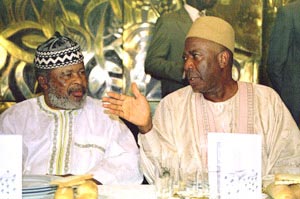Sierra Leone: A Nation Collapses

Rebel leader Foday Sankoh captured in Freetown
by David Johnson
Posted April 1999.
The vicious nine-year civil war in Sierra Leone has left this West African nation a state in name only. Despite a peace treaty signed in July 1999, fighting has again erupted and President Ahmed Tejan Kabbah's government does not extend much beyond the capital, Freetown. Several competing warlords leading their own armies control most of the rest of the country, including several of Sierra Leone's lucrative diamond mines. More than 50,000 people have died in the complicated and brutal war. Rebels have been accused of sowing a reign of terror by deliberately hacking off the arms or limbs of opponents and civilians alike. Some reports say the conflict has turned half the population, more than two million people, into refugees. Background of the Civil WarIn response to international pressure, the military government allowed multi-party elections in February 1996. These were the first multi-party elections since 1967. Kabbah's Sierra Leone People's Party won. However, Lt. Col. Johnny Paul Koroma overthrew Kabbah in May 1997. A Nigerian-led West African force, ECOMOG, restored Kabbah to power less than a year later. Subsequent negotiations between the government and various rebel factions resulted in a peace accord signed in July 1999. Several rebel leaders received government posts in exchange for supporting the agreement. U.N. Troops Held HostageUnited Nations troops began arriving in Sierra Leone in November 1999 to enforce the peace. Some ECOMOG forces joined the UN, while others withdrew. In April 2000 U.N. peacekeepers began moving into eastern Sierra Leone, home to several rebel-held diamond mines, and were promptly attacked. In May, troops of the Revolutionary United Front, RUF, one of the largest rebel factions, began capturing and holding hostage UN peacekeepers. More than 500 U.N. peacekeepers were held at one point. Many were later freed or escaped. Sankoh’s capture has increased speculation about the fate of the remaining hostages. Meanwhile, 30,000 thousand refugees flooded Freetown fearing an outbreak in fighting. [ Click here for the major players in Sierra Leone ] Sources: The New York Times, The BBC, CNN, Panafrican News Agency, World Book Encyclopedia, infoplease.com, africana.com |

